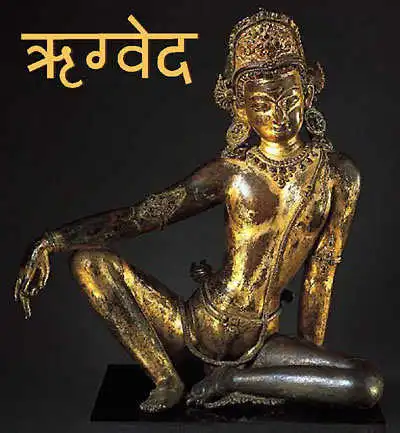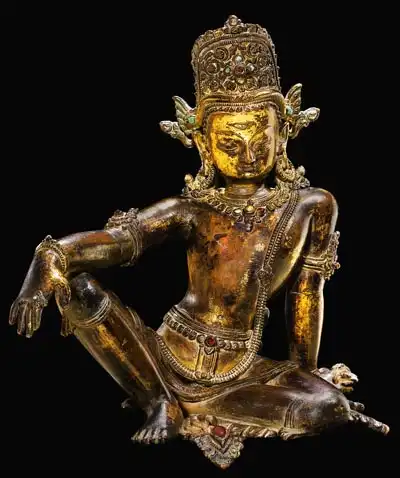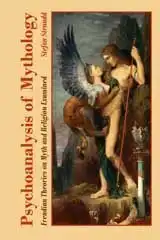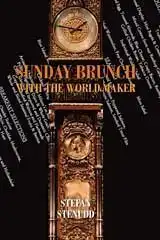
The Creation in Rig Veda 10:129Wendy Doniger O'Flaherty's Translation
Wendy Doniger O'Flaherty's Version of Rig Veda 10:129Wendy Doniger O'Flaherty is an American Indologist who has written several books about Hinduism and Sanskrit texts. Her version of Rig Veda 10:129 is from her 1981 book The Rig Veda. An Anthology.
Wendy Doniger O'Flaherty was born in New York in 1940. She holds doctoral degrees in both Sanskrit and Oriental Studies, and is the Mircea Eliade Professor of History of Religions at the University of Chicago, where she has taught since 1978. She is also one of the editors of the publication History of Religions. Presently she goes by the name Wendy Doniger. Her translation of Rig Veda 10:129 is from the book The Rig Veda. An Anthology, which was first published in 1981 by Penguin, New York. The book contains the annotated translations of 108 Vedic hymns, sorted according to subject-matter. Here is her version of Rig Veda 10:129 (p.25-26):
Rig Veda, Mandala 10, hymn CXXIX. Creation.Nasadiya Sukta ("Not the non-existent")
2 There was neither death nor immortality then. There was no distinguishing sign of night nor of day. That one breathed, windless, by its own impulse. Other than that there was nothing beyond. 3 Darkness was hidden by darkness in the beginning; with no distinguishing sign, all this was water. The life force that was covered with emptiness, that one arose through the power of heat. 4 Desire came upon that one in the beginning; that was the first seed of mind. Poets seeking in their heart with wisdom found the bond of existence in non-existence. 5 Their cord was extended across. Was there below? Was there above? There were seed-placers; there were powers. There was impulse beneath; there was giving-forth above. 6 Who really knows? Who will here proclaim it? Whence was it produced? Whence is this creation? The gods came afterwards, with the creation of this universe. Who then knows whence it has arisen? 7 Whence this creation has arisen — perhaps it formed itself, or perhaps it did not — the one who looks down on it, in the highest heaven, only he knows — or perhaps he does not know.
Provocative HymnIn a short introductory comment (p. 25), Wendy Doniger admits to the hymn being "conceptually extremely provocative" and how much trouble it has caused both Indian and Western scholars. She means that this is intentional by the poet of the hymn: "In many ways, it is meant to puzzle and challenge, to raise unanswerable questions, to pile up paradoxes."Indeed, that's the very punch line of it. But several of the difficulties she refers to are not necessarily conscious provocations by the poet. They may be misunderstandings and misinterpretations by the hymn's many commentators and translators. Except for the basic paradox of Rig Veda 10:129, that of no one being able to know how the world began, its cosmology seems intended to be quite straightforward, as if uncontroversial to the reader, maybe even familiar. To the reader contemporary to its poet, that is. Three thousand years later, it's a bit more complicated.
Realm of SpaceWith Wendy Doniger's version of Rig Veda 10:129 we move another 30 years closer to our time. Its predecessor, that of A. L. Basham, had the same time span to the one before it. Again, the modernization of the language is evident, as is the focus of the translator on making the hymn understandable beyond the scope of fellow experts.
 Wendy Doniger O'Flaherty As with Basham, some of the choices Doniger makes to facilitate for her readers seem to neglect the world view to which the poet of the hymn must have been bound. In other cases, though, her version raises interesting and relevant questions about how the hymn should be interpreted. But I do have my doubts about the "realm of space" in the first verse. That is a concept having much more meaning to the astronomy of our time than to a poet in India 3,000 years ago. It becomes even more odd followed by "the sky which is beyond" as a separate entity. Basham speaks of air and heaven instead. A. A. Macdonell's translation says air and sky, which is just about the same. So does Ralph T. H. Griffith. Max Müller speaks of a sky and heaven beyond it. H. H. Wilson is slightly closer to Doniger's solution, choosing the firmament and what is beyond it. A firmament, the idea of the sky as a dome, might have been shared by the Rig Veda hymn's poet, but it can hardly be taken for granted from the wording of the hymn. The same goes for the idea of a realm of space, especially if a sky is thought to be beyond it. What kind of sky would that be?
Primeval BreathNext, Doniger's translation asks: "What stirred?" None of the previous translations chose that word, or anything like it. The stirring starts later in the hymn, when the One is awakened.In a footnote, Doniger explains that the Indian verb she has translated as stirred is often used for the motion of breath. And she adds: "The verse implies that the action precedes the actor." That's an intriguing possibility — a breath in the primordial chaos preceding the breather. Life as a force of its own, only later taking seat in some kind of being — the One being mentioned in the second verse. It's somewhat akin to the breath (spirit) of God moving above the primordial sea of Genesis I in the Bible. Still, I find it unlikely, since none of the other translators give any inkling of such a possibility. Also, the One introduced in the second verse seems to be present from the start in that original void, or its birth would be mentioned.
That One SomethingThe original deity of Rig Veda 10:129 is simply called the One and little more is said about it. It's what Aristotle would call the first cause, the will that sets the creation into motion.Contrary to previous translations, Wendy Doniger doesn't use an upper case initial for the One. That might be a democratic streak of hers. She writes "that one". Her reason for using "that" instead of "the" is unclear. H. H. Wilson is doing the same in his translation, R. W. H. Griffith calls it "That One Thing" and Max Müller says "the only One." What they seem to suggest with their choices is that the One is impersonal — more of a thing or a power, than a conscious being. Later in the hymn, when the One is awakened, may also be the moment when it reaches consciousness and becomes somebody instead of something. Indeed, the hymn describes the One as utterly passive, no more than one ingredient in the primordial chaos. Still, it was the only thing actually present in that primary stage. So, there was something — be it just a potential later to manifest itself. But it was there, breathing.
 Indra. Gilt copper sculpture from Nepal, 15th century. Doniger says there was nothing "beyond" that One. I don't understand where a beyond would be in this pre-creation utter nothingness. It's an obscure passage causing problems for most translators. Macdonell states something similar with "no other thing than that beyond existed." Müller writes "there nothing since has been", which makes little sense. Wilson says "nothing else whatever" and Griffith the same with "nothing whatsoever". Basham deviates from the others by making it personal: "there was no other." Well, the One could hardly be anything but alone, or it wouldn't be the One. What the hymn indicates is that this One is the only distinguishable thing in the pre-creation state. What that could be, a kind of something in this nothing not even being nothing, is very hard to say.
Life ForceIn the third verse, Doniger introduces the concept of a "life force". None of her predecessors have used that expression. Müller mentions a germ, Wilson has an empty united world, Griffith speaks of a formless void, Macdonell mentions something becoming and Basham is close to it with "that One which came to be."All of them seem to be referring to the One as sort of a dormant possibility, but Doniger's choice conflicts with what comes next in the verse — the awakening of the One by heat. Then the heat would more rightly be the life force. She may be thinking of this entity as a life force simply in its role of world creator. But it does confuse the issues, since the life force in so many traditions is a concept of its own, and not identical with any kind of divine entity. Also in India, where it is called prana. I don't see why she needs to use this expression for what is probably no more than a synonym for the One.
Longing as a TriggerAbout the word for heat, Tapas, Doniger explains in a footnote that it in particular designates the heat from ritual activity and "physical mortification of the body." The latter is strange in this setting. Is there a suffering of the One in this desolate void that ignites it? Some kind of frustration, perhaps?The perspective is interesting. Many creation myths describe the loneliness of a primary being as the reason for creation. That's also implied by the biblical creation in Genesis II. The extremely ascetic situation of the One in Rig Veda 10:129 would similarly awaken a longing out of it, a longing that could easily be described as a heat. Other translations indicate something in the same direction. Wilson even substitutes the heat with "the power of austerity", but all of them describe in the next verse how desire (or love, in the case of Müller) triggers the start of creation — or at least the awakening of the creator. Who wouldn't want to get out of the dark primordial abyss?
Typos?A little preposition is the most significant difference between Wendy Doniger's translation of the fourth verse and the previous ones. She ends the verse with "the bond of existence in non-existence". The others talk about the bond between the two, not the one within the other. I suspect a simple typo in Doniger's translation, or I have no idea what she means.Like most of her predecessors, she speaks of "their" cord dividing the primordial chaos into two parts of the world we know, as if this was done by the poets mentioned in the same fifth verse. But she doesn't specify that "they" did it, so it could still conform with the most plausible interpretation of this passage of the hymn: it refers to the bond between existence and non-existence. That is also what she proposes in a footnote. On the other hand, in the same footnote she suggests an alternative: that the cord is "a kind of measuring cord by which the poets delimit — and hence create — the elements." I don't see how she could give any credibility to the idea of poets not only being present in the primordial chaos before the world was born, but also being instrumental in its creation. That's just too much, even for an ancient poet to claim about his own kind. It's strange that this passage has caused such confusion among most of the hymn's translators. There must be something in the Sanskrit wording throwing them off. Could there be a typo not only in Doniger's translation, but also in the original she and her colleagues have used?
No Original RemainingWhen dealing with ancient texts, it's important to remember that they are rarely — if ever — accessible in their original forms. Before the invention of the printing press in the 14th century, texts were copied by hand — a tedious process leading to numerous errors. That went on for several additional centuries outside Europe. And by each copying, the errors were quite likely to increase.The tenth mandala, to which this hymn belongs, is one of the latest parts of the Rig Veda. But it's still circa 3,000 years old. That's a lot of generations of copying. Things get wrong along the way. The safest way to ascertain the authenticity of an ancient text, of course, is to find an ancient manuscript. With the Veda texts, though, this is not so easy. There are Rig Veda manuscripts from the 14th and 15th centuries preserved, and the oldest Vedic manuscript found so far is from the 11th century. That creates a lot of uncertainty regarding the distant original, especially regarding its details. So, any examination of Rig Veda 10:129, as well as every ancient text preserved only in later copies, must include questions about authenticity. Errors are to be expected.
Suddenly GenderReturning to Wendy Doniger's translation, she continues to deviate from previous versions in the fifth verse. Instead of describing how the cord divides the primordial chaos into a high and a low, she asks: "Was there below? Was there above?" That's odd, since a little later in the same verse, her version confesses to a beneath and an above.Like Basham and Macdonell she has impulse, but contrary to the others she places it beneath. Above in her version is "giving-forth", an expression not used in any of the preceding versions of the hymn. She explains in a footnote: "Through chiasmus, the verse contrasts male seed-placers, giving-forth, above, with female powers, impulse, below." She says nothing about what makes her come to this conclusion, so far from the other interpretations, or what it's based on. What the hymn is most likely to state in these lines is simply that the world was divided into two, a high and a low, where the former ruled the latter. That conforms to practically every mythology we know in history, which is no final proof but a very strong argument for this interpretation. At this initial moment of creation, the poet of this hymn deals with the two major domains of the world and the divine powers as opposed to the earthly creatures they rule, not yet arriving at gender differences. As for the two remaining verses, Doniger follows the previous translations.
About Joel P. Brereton's Translation of Rig Veda 10:129The Creation in Rig Veda 10:129The Paradox of Origin
MENUCreation Myths Around the WorldHow stories of the beginning began.
The Meanings of MythologyTheories through history about myth and fable.
Archetypes in MythsThe mythological symbols and what they stand for.
The Logics of MythPatterns of creation.
CREATION MYTHS IN DEPTHCreation in Rig Veda 10:129The paradox of origin, according to an Indian myth.
Genesis 1The first creation story of the bible scrutinized.
Enuma ElishThe ancient Babylonian creation myth.
Xingu Creation of ManThe insoluble solitude of gods and humans.
ContactAbout Cookies
ON MY OTHER WEBSITESPsychoanalysis of MythWhat Sigmund Freud and C. G. Jung thought about myths, their origins and meanings.
Jungian Theories on Myth and ReligionJoseph Campbell, Jordan B. Peterson and other Jungians on mythology and religion.
Myth of CreationAn introduction to the subject of creation myths and the patterns of thought they reveal.
Cosmos of the AncientsWhat the Greek philosophers believed about the cosmos, their religion and their gods.
Life EnergyThe many ancient and modern life force beliefs all over the world explained and compared.
TaoisticTaoism, the ancient Chinese philosophy of life explained. Also, the complete classic text Tao Te Ching online.
|
 Archetypes of Mythology
Archetypes of Mythology Psychoanalysis of Mythology
Psychoanalysis of Mythology Cosmos of the Ancients
Cosmos of the Ancients Life Energy Encyclopedia
Life Energy Encyclopedia Sunday Brunch with the World Maker
Sunday Brunch with the World Maker Fake Lao Tzu Quotes
Fake Lao Tzu Quotes Stefan Stenudd
Stefan Stenudd